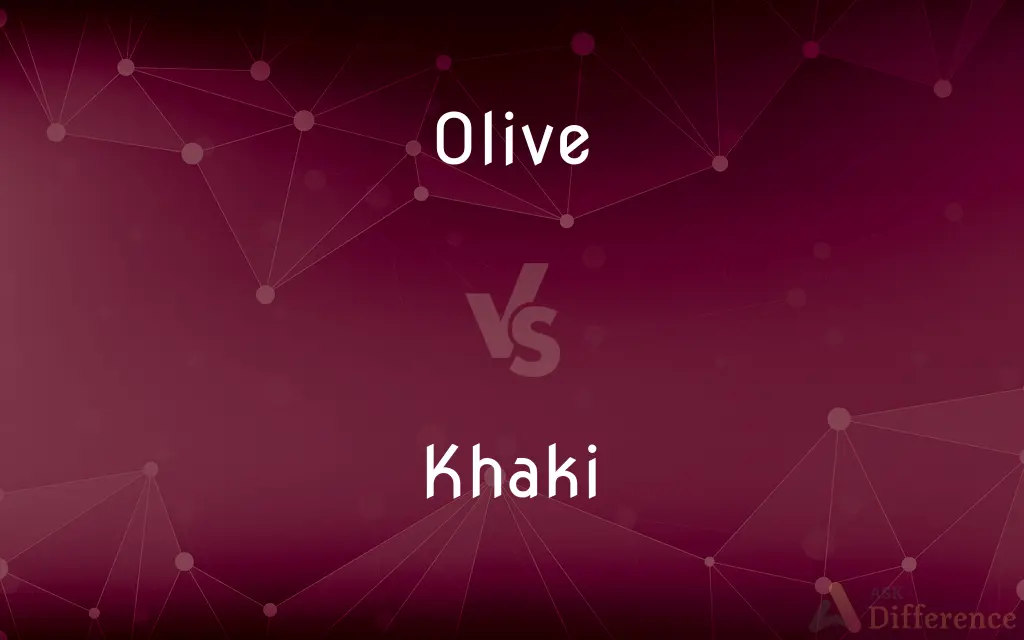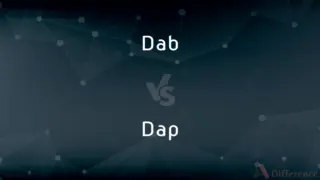Olive vs. Khaki — What's the Difference?
By Maham Liaqat & Fiza Rafique — Updated on March 14, 2024
Olive is a dark yellowish-green color, often associated with military gear, while khaki is a light brown with a hint of yellow, commonly used in uniforms.

Difference Between Olive and Khaki
Table of Contents
ADVERTISEMENT
Key Differences
Olive and khaki are both colors widely used in clothing, especially in military and outdoor apparel. Olive, a deeper, yellowish-green hue, reflects the color of olive drab, which is traditionally associated with military equipment and uniforms. This color is known for its association with nature, camouflage, and utility. Khaki, on the other hand, is a lighter shade of brown with a hint of yellow, originally derived from the Persian word "khak," meaning dust. It became associated with military uniforms due to its use by British troops in colonial India, where its dust-like color provided effective camouflage in desert and semi-desert regions.
The use of olive in fashion and design often conveys a rugged, outdoor, or military aesthetic, highlighting its connection to the natural world and durability. Khaki, while also associated with military and outdoor gear, tends to convey a more casual, versatile, and sometimes formal appearance, making it a popular choice for workwear, casual pants, and uniforms.
Olive's darker, richer tone makes it more suitable for concealment in varied natural landscapes, especially forests and grasslands, which is why it is favored for military camouflage in such environments. Khaki's lighter tone, however, is better suited for desert and urban environments, offering both a practical and aesthetic choice for clothing and gear intended for these settings.
In terms of color combinations and fashion, olive is often paired with other earth tones, dark colors, or metallics for a natural or military-inspired look. Khaki is considered more neutral and versatile, easily pairing with a wide range of colors, from bright and bold to soft and pastel, making it a staple in both casual and professional wardrobes.
Both colors have transcended their military origins to become staples in civilian fashion, offering different vibes and uses. Olive is often chosen for its bold, natural look, suitable for statement pieces or outdoor gear. Khaki, with its neutral and lighter tone, serves as a versatile base for a variety of styles, from casual to semi-formal.
ADVERTISEMENT
Comparison Chart
Color Tone
Dark yellowish-green
Light brown with a hint of yellow
Military Use
Camouflage in forested areas
Camouflage in desert and urban areas
Fashion Use
Outdoor, rugged, military-inspired
Casual, versatile, semi-formal
Color Combinations
Pairs with earth tones and dark colors
Pairs widely with many colors
Origin
Associated with olive drab color
Derived from Persian word for dust
Compare with Definitions
Olive
A dark yellowish-green color.
The olive jacket blended well with the forest surroundings.
Khaki
Conveys a casual and sometimes formal appearance.
He chose a khaki suit for the outdoor summer wedding.
Olive
Reflects durability and connection to nature.
The olive-colored tent was perfect for camping in the woods.
Khaki
Commonly used in military and workwear.
The workers wore khaki uniforms for better visibility and uniformity.
Olive
Often associated with military gear.
He wore an olive backpack designed for tactical use.
Khaki
Versatile in fashion combinations.
She paired her khaki skirt with a bright blue blouse for a cheerful look.
Olive
Suitable for statement pieces in fashion.
Her olive scarf added a touch of rugged elegance to her outfit.
Khaki
Originates from military use in desert regions.
Khaki was chosen for military uniforms in desert campaigns for its blending properties.
Olive
Favored for its camouflage properties.
Olive uniforms are used by the army for operations in green landscapes
Khaki
.
Olive
The olive, known by the botanical name Olea europaea, meaning "European olive", is a species of small tree in the family Oleaceae, found traditionally in the Mediterranean Basin. The species is cultivated in all the countries of the Mediterranean, as well as in Australia, New Zealand, North and South America and South Africa.
Khaki
A light brown color with a hint of yellow.
The khaki chinos were a versatile addition to his wardrobe.
Olive
A small oval fruit with a hard stone and bitter flesh, green when unripe and bluish black when ripe, used as food and as a source of oil
A cucumber and olive salad
A dish of cauliflower with black olives
Khaki
Khaki (UK: , US: ) is a color, a light shade of brown with a yellowish tinge. Khaki has been used by many armies around the world for uniforms, including camouflage.
Olive
The small evergreen tree which produces olives and which has narrow leaves with silvery undersides, native to warm regions of the Old World.
Khaki
A strong cotton or wool fabric of a dull brownish-yellow colour, used especially in military clothing
He was dressed from head to toe in khaki
A regulation-issue khaki overall
Olive
A greyish-green colour like that of an unripe olive
Shades of gold, olive, and black
Khaki
A dull greenish or brownish-yellow colour
A pair of khaki Bermuda shorts
Olive
A slice of beef or veal made into a roll with stuffing inside and stewed.
Khaki
A light olive brown to moderate or light yellowish brown.
Olive
A marine mollusc with a smooth, roughly cylindrical shell which is typically brightly coloured.
Khaki
A sturdy cloth of this color.
Olive
Each of a pair of smooth, oval swellings in the medulla oblongata.
Khaki
Khakis A uniform made of this cloth.
Olive
A metal ring or fitting which is tightened under a threaded nut to form a seal, as in a compression joint.
Khaki
Khakis Pants made of a twilled cotton fabric of this color or another solid color.
Olive
Greyish-green
A small figure in olive fatigues
Khaki
A dull, yellowish-brown colour, the colour of dust.
Olive
A widely cultivated evergreen tree (Olea europaea) native to the Mediterranean region, having fragrant white flowers, gray-green lance-shaped leathery leaves, and edible fruit with oil-rich flesh surrounding a hard stone.
Khaki
Khaki green, a dull green colour.
Olive
The small oval fruit of this tree, usually changing in color from green to black as it ripens, used for food and as a source of oil.
Khaki
A strong cloth of wool or cotton, often used for military or other uniforms.
Olive
Any of various similar or related plants, such as the Russian olive.
Khaki
(rare) A soldier wearing a khaki uniform.
Olive
A yellow green of low to medium lightness and low to moderate saturation.
Khaki
A British person (from the colour of the uniform of British troops, originally in the Second Boer War; compare rooinek). In this sense the plural generally is khakies.
Olive
A tree, Olea europaea, cultivated since ancient times in the Mediterranean for its fruit and the oil obtained from it.
Khaki
(often in plural) Khaki clothing or uniform.
Olive
The small oval fruit of this tree, eaten ripe (usually black) or unripe (usually green).
Khaki
Dust-coloured; of the colour of dust.
Olive
The wood of the olive tree.
Khaki
Of a dull brownish yellow, or drab color; - applied to cloth, originally to a stout brownish cotton cloth, used in making uniforms in the Anglo-Indian army.
Olive
A dark yellowish-green color, that of an unripe olive.
Khaki
Any kind of khaki cloth; hence, a uniform of khaki or, rarely, a soldier clad in khaki. In the United States and British armies khaki or cloth of a very similar color is almost exclusively used for service in the field.
Olive
(neuroanatomy) An olivary body, part of the medulla oblongata.
Khaki
A sturdy twilled cloth of a yellowish brown color used especially for military uniforms
Olive
A component of a plumbing compression joint; a ring which is placed between the nut and the pipe and compressed during fastening to provide a seal.
Khaki
Of a yellowish brown color
Olive
(cookery) A small slice of meat seasoned, rolled up, and cooked.
A beef olive
Olives of veal
Olive
Any shell of the genus Oliva and allied genera; so called from the shape.
Olive
An oystercatcher, a shore bird.
Olive
Of a grayish green color, that of an unripe olive.
Olive
A tree (Olea Europæa) with small oblong or elliptical leaves, axillary clusters of flowers, and oval, one-seeded drupes. The tree has been cultivated for its fruit for thousands of years, and its branches are the emblems of peace. The wood is yellowish brown and beautifully variegated.
Olive
Any shell of the genus Oliva and allied genera; - so called from the form. See Oliva.
Olive
The color of the olive, a peculiar dark brownish, yellowish, or tawny green.
Olive
An olivary body. See under Olivary.
Olive
A small slice of meat seasoned, rolled up, and cooked; as, olives of beef or veal.
Olive
Approaching the color of the olive; of a peculiar dark brownish, yellowish, or tawny green.
Olive
Small ovoid fruit of the European olive tree; important food and source of oil
Olive
Evergreen tree cultivated in the Mediterranean region since antiquity and now elsewhere; has edible shiny black fruits
Olive
Hard yellow often variegated wood of an olive tree; used in cabinetwork
Olive
One-seeded fruit of the European olive tree usually pickled and used as a relish
Olive
A yellow-green color of low brightness and saturation
Olive
Of a yellow-green color similar to that of an unripe olive
Common Curiosities
Why is olive associated with the military?
Olive is associated with the military due to its use in olive drab uniforms and equipment, which offer effective camouflage in natural environments.
What is the history behind the color khaki in military uniforms?
Khaki became associated with military uniforms due to its effectiveness in providing camouflage in desert and semi-desert regions, beginning with British troops in colonial India.
Can olive and khaki be used together in fashion?
Yes, olive and khaki can be combined in fashion, often used together for a cohesive, earth-toned look that emphasizes a connection to nature and utility.
How do olive and khaki compare in terms of color psychology?
Olive is perceived as a color of peace, nature, and military strength, conveying stability and endurance. Khaki, being neutral, is seen as practical, reliable, and adaptable, making it a popular choice for conveying simplicity and efficiency.
What makes khaki a versatile color in wardrobes?
Khaki's light brown shade with a hint of yellow makes it a neutral color that can easily pair with a wide range of other colors, enhancing its versatility for various styles and occasions.
Are there any specific occasions where olive or khaki is more appropriate?
Olive is more suited to outdoor, adventurous, or casual settings, while khaki, due to its versatility and sometimes formal appearance, can be appropriate for a wider range of occasions, including work and semi-formal events.
How do the uses of olive and khaki differ in civilian clothing?
Olive is often used for bold, statement pieces and outdoor gear, emphasizing a rugged aesthetic, while khaki is prized for its versatility, serving as a neutral base in both casual and semi-formal attire.
What are some popular items of clothing in olive and khaki?
Popular olive items include military jackets, cargo pants, and outdoor apparel. For khaki, chinos, work shirts, and casual suits are common choices.
How do designers use olive and khaki in modern fashion?
Designers use olive for its bold, natural aesthetic, often in fall and winter collections, while khaki is utilized year-round for its neutral, versatile appeal in everything from casual wear to more formal attire.
How has the perception of olive and khaki colors evolved over time?
Both colors have evolved from strictly military use to become fundamental in fashion, signifying not just utility but also style, versatility, and a connection to nature.
Share Your Discovery

Previous Comparison
Dab vs. Dap
Next Comparison
Boom vs. BoonAuthor Spotlight
Written by
Maham LiaqatCo-written by
Fiza RafiqueFiza Rafique is a skilled content writer at AskDifference.com, where she meticulously refines and enhances written pieces. Drawing from her vast editorial expertise, Fiza ensures clarity, accuracy, and precision in every article. Passionate about language, she continually seeks to elevate the quality of content for readers worldwide.














































